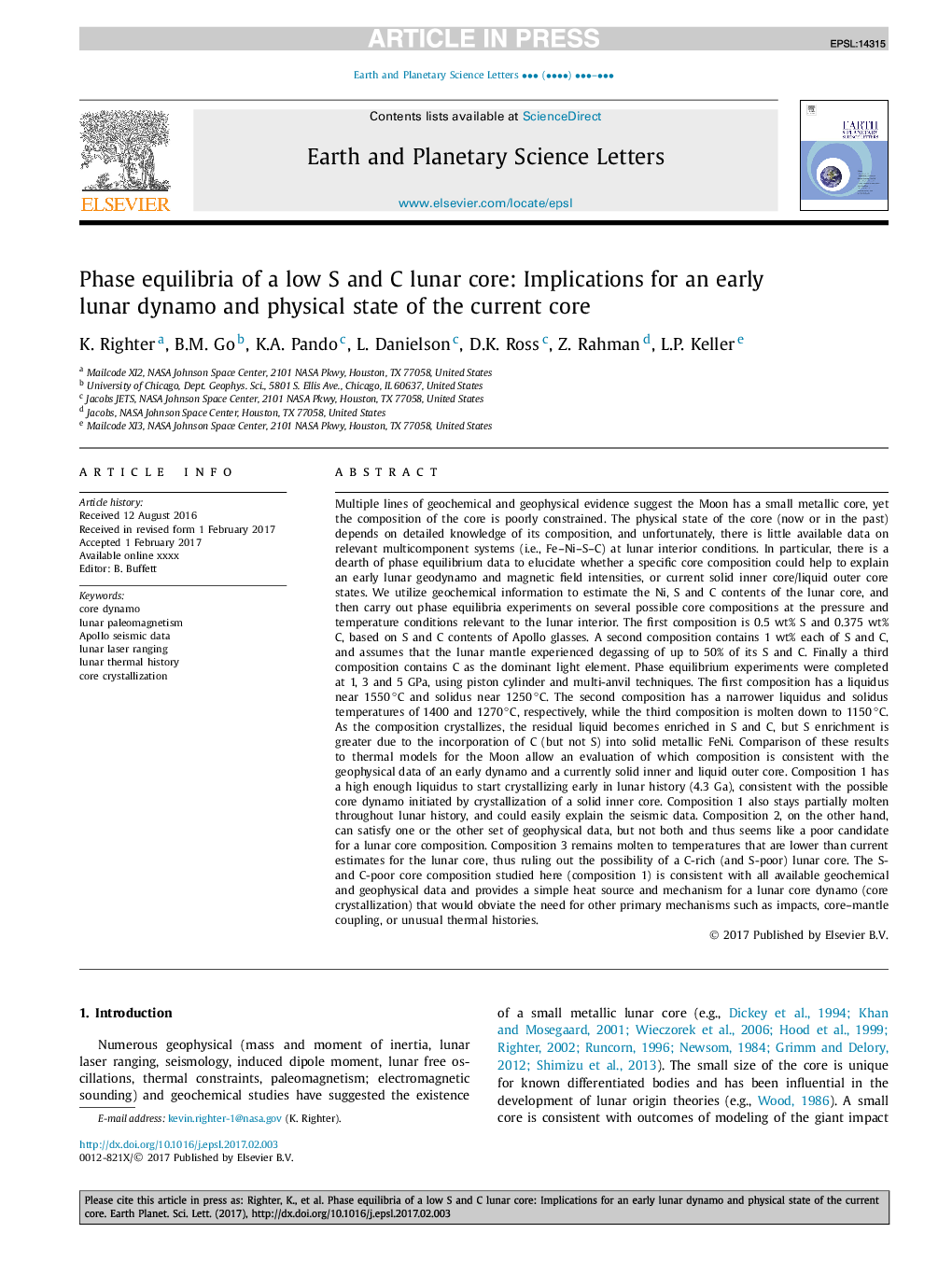| کد مقاله | کد نشریه | سال انتشار | مقاله انگلیسی | نسخه تمام متن |
|---|---|---|---|---|
| 5780115 | 1634693 | 2017 | 10 صفحه PDF | دانلود رایگان |
عنوان انگلیسی مقاله ISI
Phase equilibria of a low S and C lunar core: Implications for an early lunar dynamo and physical state of the current core
دانلود مقاله + سفارش ترجمه
دانلود مقاله ISI انگلیسی
رایگان برای ایرانیان
کلمات کلیدی
موضوعات مرتبط
مهندسی و علوم پایه
علوم زمین و سیارات
علوم زمین و سیاره ای (عمومی)
پیش نمایش صفحه اول مقاله

چکیده انگلیسی
Multiple lines of geochemical and geophysical evidence suggest the Moon has a small metallic core, yet the composition of the core is poorly constrained. The physical state of the core (now or in the past) depends on detailed knowledge of its composition, and unfortunately, there is little available data on relevant multicomponent systems (i.e., Fe-Ni-S-C) at lunar interior conditions. In particular, there is a dearth of phase equilibrium data to elucidate whether a specific core composition could help to explain an early lunar geodynamo and magnetic field intensities, or current solid inner core/liquid outer core states. We utilize geochemical information to estimate the Ni, S and C contents of the lunar core, and then carry out phase equilibria experiments on several possible core compositions at the pressure and temperature conditions relevant to the lunar interior. The first composition is 0.5 wt% S and 0.375 wt% C, based on S and C contents of Apollo glasses. A second composition contains 1 wt% each of S and C, and assumes that the lunar mantle experienced degassing of up to 50% of its S and C. Finally a third composition contains C as the dominant light element. Phase equilibrium experiments were completed at 1, 3 and 5 GPa, using piston cylinder and multi-anvil techniques. The first composition has a liquidus near 1550â°C and solidus near 1250â°C. The second composition has a narrower liquidus and solidus temperatures of 1400 and 1270â°C, respectively, while the third composition is molten down to 1150â°C. As the composition crystallizes, the residual liquid becomes enriched in S and C, but S enrichment is greater due to the incorporation of C (but not S) into solid metallic FeNi. Comparison of these results to thermal models for the Moon allow an evaluation of which composition is consistent with the geophysical data of an early dynamo and a currently solid inner and liquid outer core. Composition 1 has a high enough liquidus to start crystallizing early in lunar history (4.3 Ga), consistent with the possible core dynamo initiated by crystallization of a solid inner core. Composition 1 also stays partially molten throughout lunar history, and could easily explain the seismic data. Composition 2, on the other hand, can satisfy one or the other set of geophysical data, but not both and thus seems like a poor candidate for a lunar core composition. Composition 3 remains molten to temperatures that are lower than current estimates for the lunar core, thus ruling out the possibility of a C-rich (and S-poor) lunar core. The S- and C-poor core composition studied here (composition 1) is consistent with all available geochemical and geophysical data and provides a simple heat source and mechanism for a lunar core dynamo (core crystallization) that would obviate the need for other primary mechanisms such as impacts, core-mantle coupling, or unusual thermal histories.
ناشر
Database: Elsevier - ScienceDirect (ساینس دایرکت)
Journal: Earth and Planetary Science Letters - Volume 463, 1 April 2017, Pages 323-332
Journal: Earth and Planetary Science Letters - Volume 463, 1 April 2017, Pages 323-332
نویسندگان
K. Righter, B.M. Go, K.A. Pando, L. Danielson, D.K. Ross, Z. Rahman, L.P. Keller,